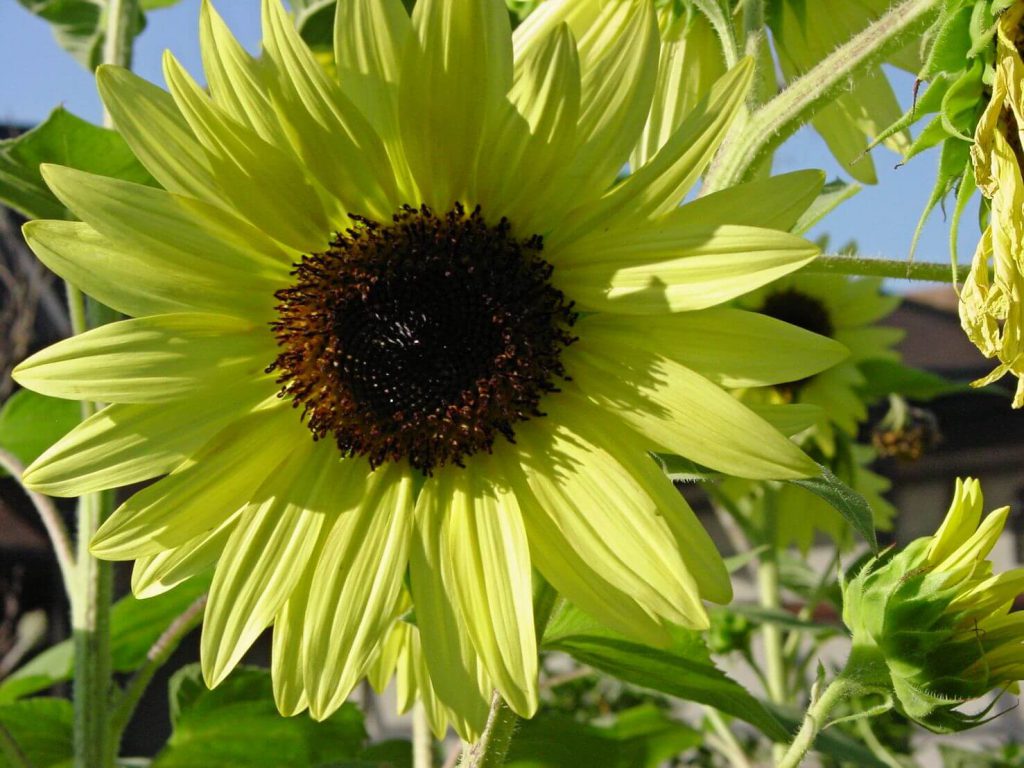 The Sunflower or Helianthus annuus is in the same family as marigolds and lettuce, and has been used in some form or another since 3000 B. C. in North America. Whether you know this plant as an ornamental, a tasty snack food, or even a symbol, the common sunflower has been a real benefit to gardeners and the world in terms of beauty and food.
The Sunflower or Helianthus annuus is in the same family as marigolds and lettuce, and has been used in some form or another since 3000 B. C. in North America. Whether you know this plant as an ornamental, a tasty snack food, or even a symbol, the common sunflower has been a real benefit to gardeners and the world in terms of beauty and food.
The sunflower is a true native North American plant with many uses. Initially, sunflowers were used as a food source by Native American populations. The seed was ground into flour to make protein-rich breads and mixed with other food. Spanish explorers brought the sunflower back to the Old World where it was a popular ornamental. History notes the Russians as using sunflowers for oil. Recently, the sunflower has gained popularity as a cut flower with florists. Sunflower seeds are also a popular snack food. The birdseed industry credits sunflowers with an abundant harvest of a songbird’s favorite kernels. The gardener has enjoyed this large flower as a staple annual ornamental. The sunflower affects almost all of us in some manner.
Botanically speaking, the sunflower has a blossom made up of a cluster of flowers (disk flowers) that form the head. The outer petals of the head make up the ray flower portion of the flower. The sunflower is part of the Compositae family which, as mentioned above, includes not only lettuce and marigolds, but also dandelions, asters, chrysanthemums, and thistles – I am sure that you can see the family resemblance! While many of the old common types are well over five feet tall with yellow blooms, sunflower breeders have produced an abundance of new colors ranging from orange, gold, lemon yellow, bronze, amber, red, and white. Some types have multiple heads good for floral arrangements, while others are now available as double-flowering. Sunflowers are drought tolerant, do best in full sun, and are not fussy about soil conditions. They are commonly used in the landscape for borders, as temporary screening, or in containers. They grow best when direct seeded, so plan before you plant – seed in late winter to early spring for flowers in mid-spring. By late spring to early-summer, the heat can cause a quick decline in sunflowers, so take a break until fall for a repeat flower display.
If seeds are saved for birds or your own consumption, cut the head off with a portion of the stem remaining and let it dry under cover hanging in a paper bag for a several weeks.
Sunflowers can make quite an impact, even temporarily, in a landscape by providing color and a fun gardening activity for both adults and youth! For more information on all types of annual flowers suitable for our area, and when to plant them, please call our Master Gardener volunteers on the Plant Lifeline on Mondays, Wednesdays and Fridays from 1 to 4 pm at 764-4340 for gardening help and insight into their role as an Extension volunteer. Don’t forget to visit our other County Plant Clinics in the area. Please check this link for a complete list of site locations, dates and times – https://blogs.ifas.ufl.edu/charlotteco/files/2018/03/Plant-Clinics-Schedule.pdf. Ralph E. Mitchell is the Director/Horticulture Agent for the Charlotte County Extension Service. He can be reached at 941-764-4344 or ralph.mitchell@charlottecountyfl.gov.
Resources:
Gilman, E. F. (2014) Helianthus annuus ‘Sonja’ Sonja Sunflower. The University of Florida Extension Service, IFAS
Schoellhorn, R., Emino, E., E. Alvarez, & Frank, M. (2015) Warm Climate Production Guidelines for Specialty Cut Flowers: Sunflower. The University of Florida Extension Service, IFAS
2003 Sunflower Trails Cultivars – https://hort.ifas.ufl.edu/floriculture/cut_flower/cultivars_alphabetical.shtml
Sunflowers – Gardening Solutions http://gardeningsolutions.ifas.ufl.edu/plants/ornamentals/sunflowers.html
Lerner, B. R. (1996) Yard and Garden News, ‘Celebrate the Year of the Sunflower’ National Garden Bureau (1996) The Year of the Sunflower
Dessart, D. (1994) The Sunflower: Symbol & Seed, OCEAN
Definition of ‘helianthus’ – https://www.collinsdictionary.com/dictionary/english/helianthus
Helianthus – https://en.wikipedia.org/wiki/Helianthus
 0
0
